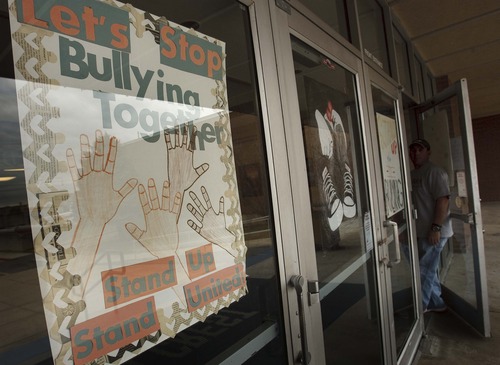This is an archived article that was published on sltrib.com in 2014, and information in the article may be outdated. It is provided only for personal research purposes and may not be reprinted.
Sad to say, but bullying does not just exist in the schoolyard. It is alive and well in the workplace.
We probably all know what the obvious signs of bullying look like. Examples include: offensive communication (using profanity, gossip or derisive jokes); aggression (yelling or shouting at an employee); coercion (forcing someone to say or do things against their will); belittling or demeaning someone regarding their ideas or work; embarrassing, degrading or humiliating someone publicly in front of others; retaliation; threats; blocking the advancement or growth of someone, or actively campaigning to get rid of them.
In addition to these obvious forms of bullying, there are many subtle forms that may not easily be detected but still cause emotional damage. Perhaps a bully is in charge of taking photos at a key event. He/she may take pictures of everyone but their victim to let them know who is in control. Maybe the bully acts chummy with the victim's friends or share jokes and social events with everyone but the victim. These are forms of socially isolating the victim.
Bullies may constantly justify their behavior or make excuses for it ("I raised my voice because I am going through a bad time right now"). They may act oblivious or dumb ("Oh, I didn't know that was important to you"). They may constantly blame the victim or use him/her as a scapegoat. One tactic that I have heard used a lot is pitting employees against each other so that they will turn against each other. This way, the bully comes out as the winner.
As managers, bullies may set unrealistic expectations or set their employees up to fail. They may also display sudden mood swings, making them unpredictable. They may take credit for others' ideas without acknowledging them. They may lie or distort the truth about what others have said in order to advance their own agendas. For example, the person may say, "Josh said this is how we should run the meeting" since that is how the bully wants to run it, when in fact, Josh never said that at all.
Really clever bullies are manipulators who are skilled at reading others and understanding their weaknesses so they know how to exploit them. In fact, many bullies can disguise their bullying behind a very nice and charming demeanor and a "pure" or noble cause. For example, they may demean a group of employees by arguing passionately that getting rid of them or limiting their power will be for the "good of the entire institution." Thus, it may initially be hard to detect the bullying. Also, bullying often reflects a pattern of actions over a long course of time so it may actually go undetected in the workplace, yet still have substantial costs to an employer.
Bullies often initially try to befriend their victims. They may use excessive flattery and praise to get others to trust them, lower their guard and be more responsive to their manipulations. And, because people, especially bosses, often want to believe the compliments, they fall prey. They see the bully as a "stand up" person.
For employers, there are huge tangible and intangible costs associated with workplace bullying, whether overt or subtle bullying. These can be financial and interpersonal and can affect morale, productivity and turnover, among other metrics.
Employees who are victims of bullying may experience anger, frustration and a feeling of being disrespected or treated unfairly to such a level that they plan to quit or do quit. They may feel confused or miserable at work. Their performance may drop because they are so afraid of being criticized that they are indecisive. They can also experience numerous physical problems such as inability to concentrate, insomnia, stomach pains, anxiety and other sicknesses. A culture where bullying exists may report more absenteeism, turnover, stress, costs for employee assistance programs, risks for accidents and decreased morale, productivity and customer service. And, it's not just work that is affected. I have heard employees tell me about how their home lives were greatly affected since they spent so much mental energy stressing about their toxic work situation.
Whether obvious or subtle, bullying is extremely damaging to a workplace. To address it, managers must clearly define what bullying is, what the behaviors are, and provide clear examples of unacceptable behaviors. They should have a policy that clearly states the consequences of engaging in bullying behaviors. Then, they must act to rid the workplace of the bully and his or her behaviors. Otherwise, they will most likely lose many of their very talented employees.
Russell is the vice dean and the director of the Executive Coaching and Leadership Development Program at the University of Maryland's Robert H. Smith School of Business. She is a licensed industrial and organizational psychologist and has more than 25 years of experience coaching executives and consulting on leadership and career management.



